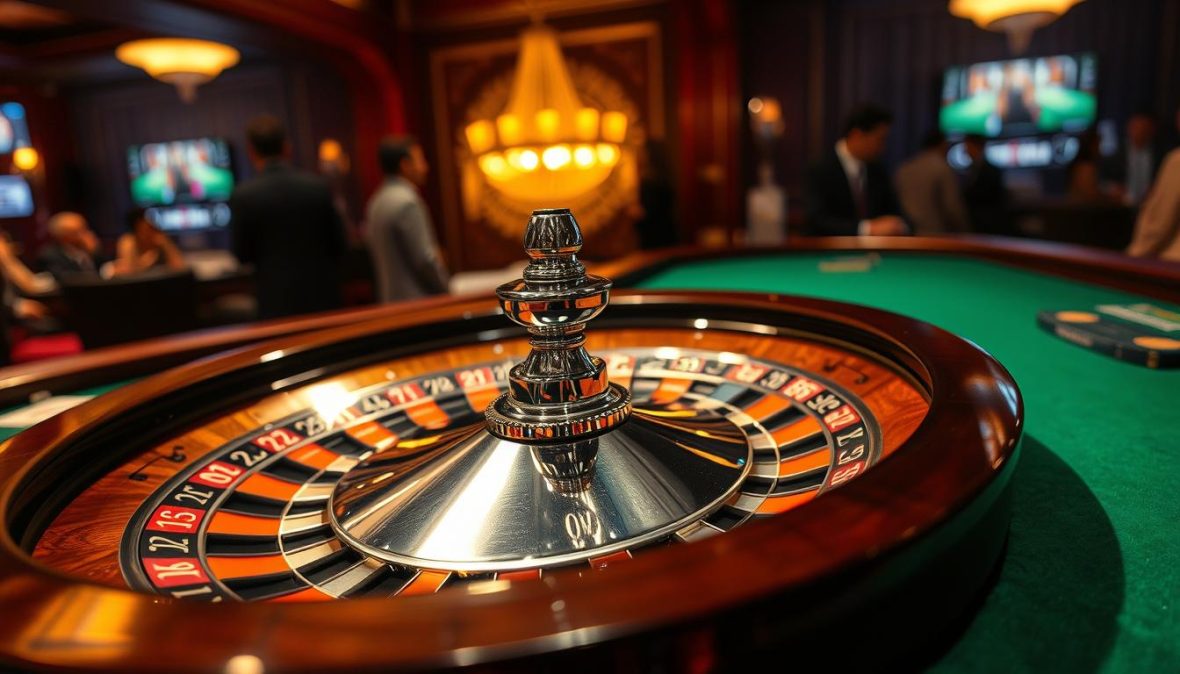Roulette Strategy Guide: Maximize Your Chances of Winning

Fact: the house edge jumps from about 2.7% on a single-zero wheel to roughly 5.26% on a double-zero wheel — a quiet tax on every bet you place.
I’ve learned one simple truth at the table: a clear plan helps you manage risk and keep more money in play, but it does not beat the math. I’ll be frank — no system flips the edge. What we can do is shape decisions, limit losses, and extend the fun.
This short guide shows how I read a wheel, choose a table, and use practical betting rules to stay disciplined when the game gets fast. You’ll see why coverage systems trade small, frequent wins for rare, larger losses and how progression methods run into table limits and variance.
I’ll reference evidence and link to useful resources like the best roulette payout guide so you can check the numbers yourself. No magic. Just clear, usable advice to help players make smarter choices with their time and money.
Key Takeaways
- Single-zero vs double-zero: wheel design changes the house edge significantly.
- Plans manage risk and session length but don’t change expected return.
- Coverage systems raise hit rate but increase occasional big losses.
- Set unit size and stop rules before you sit down at the table.
- Use evidence-based sources to evaluate any approach you try.
Understand the real odds before you bet
Begin every session by spotting the wheel type; it matters more than most players think. I check for single-zero (European) or double-zero (American) first. That choice alone changes the long-run math on every bet.
Quick facts: a European wheel has 37 pockets (1–36 plus 0) so the house edge is ~2.7%. An American wheel has 38 pockets (1–36, 0 and 00) and a house edge of ~5.26%. Even-money bets like red black or odd even are slightly under 50% because of the zero pockets.
Coverage increases hit rate but not expected value. Romanovsky covers 32 of 37 numbers — ~86.48% hit rate on a European wheel — yet the zero still drains returns over time. The James Bond spread shows how coverage maps to outcomes: common payouts and a clear losing range when 1–12 hits.
- Tip: note the table min/max before you play.
- Reminder: every spin is independent; ignore streak myths.
Knowing the edge helps set sensible unit sizes and realistic goals. Pick the friendlier table first, then pick your plan.
How to apply a roulette strategy step by step
My play begins with a simple pact—no chasing, fixed base unit, and pre-set loss limits. Below I walk through common approaches and show practical chip placements, ladder caps, and session guardrails you can use right away.
Martingale: double after a loss
I place an even-money bet (bet color or odd even) with a tiny base unit. After a loss I double bet to recover prior losses plus one unit. Guardrail: cap the ladder so table max or bankroll never force a ruinous final wager.
Reverse Martingale / Paroli
Increase after wins, drop to base after a loss. I predefine a ladder length (2–3 rungs). It rides hot streaks and protects the base if the run fails.
D’Alembert basics
The d’alembert strategy raises one unit after a loss and drops one after a win. It smooths variance. I use it for calm sessions and set a modest session length.
Fibonacci sequence
Follow 1,1,2,3,5… move forward on a loss and step back two after a win. Stakes rise slowly at first. My rule: stop if the next amount exceeds 5% of bankroll.
James Bond spread
Chip placement: 140 on 19–36, 50 on 13–18, 10 on 0. Typical outcomes: +80, +100, or +160. If 1–12 hits you lose the whole layout. I use this only with a small base unit.
Romanovsky high coverage
Two dozens plus two corner bets cover 32 of 37 numbers (on European wheels). Wins are frequent and small. I prefer it when I want steady action and low per-spin amount.
Bankroll guardrails & session rules
- Base unit: 0.5–1% of bankroll.
- Stop-loss: preset at 1–2 base stacks.
- Stop-win: bank +20–30 units then quit.
- Cap ladder heights and log every spin and amount.
| Method | Core idea | Typical placement | Risk |
|---|---|---|---|
| Martingale | Double after loss | Even-money lanes | Hitting table max or bankroll cap |
| Paroli | Increase after wins | Step-up ladders (2–3) | Lose ladder if one spin fails |
| d’alembert strategy | +1 after loss, −1 after win | Small unit increments | Slow escalation; needs balanced wins |
| Fibonacci | Sequence progression | 1,1,2,3,5… | Stake escalation in long runs |
Evidence-led roulette play with statistics and sources
Data tells a clearer story than hot tips; I trust the numbers first. Below I map coverage versus payout and call out the concrete stats any serious player should keep on hand.
Graph description: coverage vs net payout
I chart coverage on the x-axis and typical net payout on the y-axis for Martingale, Paroli, D’Alembert, Fibonacci, James Bond, and Romanovsky. Romanovsky sits far right with high coverage and low per-hit return. James Bond sits mid-range. Progression plans cluster by stake escalation, not by true coverage.
Key statistics to memorize
- House edges: European ~2.7% | American ~5.26%.
- Romanovsky hit rate: 32/37 numbers → ~86.48% on single-zero.
- Even-money bets win under 50% because of the zero pocket(s).
- Historic tail risk: 32 reds occurred in 1943 — rare, but possible.
Reality check and best practice
Past spins don’t change future spins; each spin is independent.
Like martingale systems, most approaches do not change expected value. They only reshape outcome distribution — many small wins and occasional large losses. Choose European wheels when you can, measure sessions in units, and avoid ladders that touch table limits.
For a lighter read on odds and memes that illustrate common misperceptions, see this fun odds roundup.
| Method | Coverage | Typical net per hit | Primary risk |
|---|---|---|---|
| Martingale | Even-money lanes (~48–49%) | Small unit wins, rare big loss | Table limits / bankroll ruin |
| James Bond | Medium (covers dozens + single) | Moderate mixed payouts (+80 to +160) | Full layout loss on 1–12 |
| Romanovsky | High (~86.48% on EU wheel) | Frequent small wins | Compressed profit; cumulative erosion |
Tools to limit losses and track performance in real time
I always build a tiny toolkit: calculators, a tracker, and a simple risk snapshot. These tools keep decisions clear and protect my money when the action accelerates.
Bankroll and unit-size calculator: enter your total money, pick a unit (0.5–1% of bankroll), and the sheet shows max ladder depth before the table max stops you. Use it to set base units and to limit losses before you bet.
Spin and bet tracker template
Keep a simple log with columns: spin #, bet place, amount, outcome, net, tilt meter. Update each spin. Over a few sessions you’ll spot where bets bleed and which plays cost time and money.
Risk snapshot: session length and stress tests
Create a quick chart comparing flat versus progressive runs. Flat bets stretch time and reduce volatility. Martingale and Fibonacci escalate stakes and can hit the table cap fast.
- Stop rules: set stop-loss in units (example: 20) and a cool-down trigger after three consecutive losses.
- Precompute rungs: list every progressive amount so you never do math under pressure.
- Table selection tool: log min/max, wheel type, and crowd pace to pick the right roulette table for your plan.
| Tool | Purpose | Quick action |
|---|---|---|
| Bankroll calculator | Size units and ladder depth | Adjust unit % until ladder fits |
| Spin tracker | Monitor variance | Export weekly and review losses |
| Stress test | Simulate bad runs | Reduce unit if five misses wipe plan |
Protecting money means protecting mindset—stop when the tilt meter climbs.
Prediction models and scenario planning for your next table
Prediction is less prophecy and more practical bookkeeping for the session ahead.
I model outcomes per 100 spins to set realistic targets. On a European wheel the house edge is ~2.7%; on an American wheel it’s ~5.26%. If you average 1 unit per spin, multiply total action (100 units) by the edge to see expected shortfall.
What to expect per hundred spins with American and European rules
Simple scenario: 100 spins at 1 unit each → expected drain ≈ 2.7 units on European, ≈ 5.26 units on American. It’s a compass, not a promise.
High-coverage methods like Romanovsky give frequent small positives and occasional larger drawdowns. Progressions concentrate risk; a long losing run can hit the table max and wipe a session.
Setting win/loss stops and choosing tables with optimal limits
My rules: set a profit target (+20–30 units) and a hard stop (−20 units). Add a soft reassess stop (−12 units) to prevent tilt. When you hit a win target, skim chips into the rack and drop to base unit — that’s a simple way to lock some profit.
- Table choice: pick European when available; favor a wide max/min gap to support progressions.
- Method fit: flat bets tighten variance; Paroli rides wins; Martingale piles risk into cliff moments.
- Stress test: model five consecutive misses on even bets and check recovery needs.
“The system works” is a slogan, not a plan — treat each approach as a tool with limits.
| Focus | Practical rule | Why it matters |
|---|---|---|
| Profit target | +20–30 units | Locks gains before edge erodes them |
| Hard stop | −20 units | Prevents bankroll ruin |
| Table selection | European, high max/min | Better long-run math and room for progressions |
Short sessions, disciplined stops, and partial banking increase your chance to leave ahead. Over more time, the edge pulls results toward expectation. Use models to manage risk, not to promise wins.
Conclusion
Before you walk away, lock a few simple habits that protect your money and mood.
My closing take: pick the roulette strategy that fits your temperament, size units conservatively, and respect hard stops. That’s the practical way to make volatile play feel controlled.
Quick FAQ:
Does any betting system beat the edge? No. Use systems to shape variance, not to chase certainty.
European or American wheel? Choose a European roulette wheel when possible for a lower house edge.
Is James Bond a shortcut? james bond wins often but crashes on 1–12; know the tradeoff.
Should I bet black after a red run? Don’t—red black streaks don’t change the next spin.
Pre-bet checklist: confirm wheel type, read table limits, pick base amount, set stop-win/stop-loss, and open your tracker.
Final pointer: bank wins, cap progressions, and play your plan—not the last spin.
